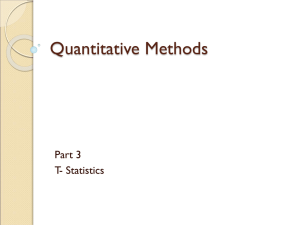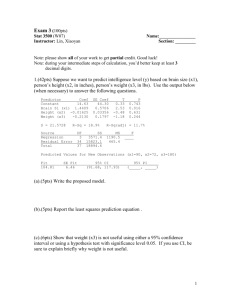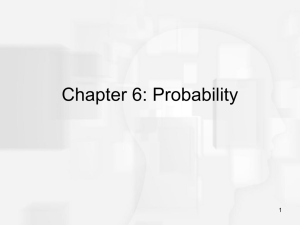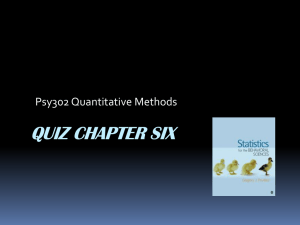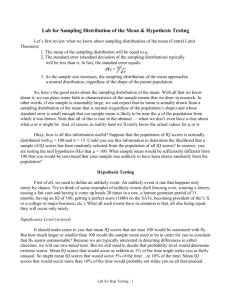obtained mean
advertisement
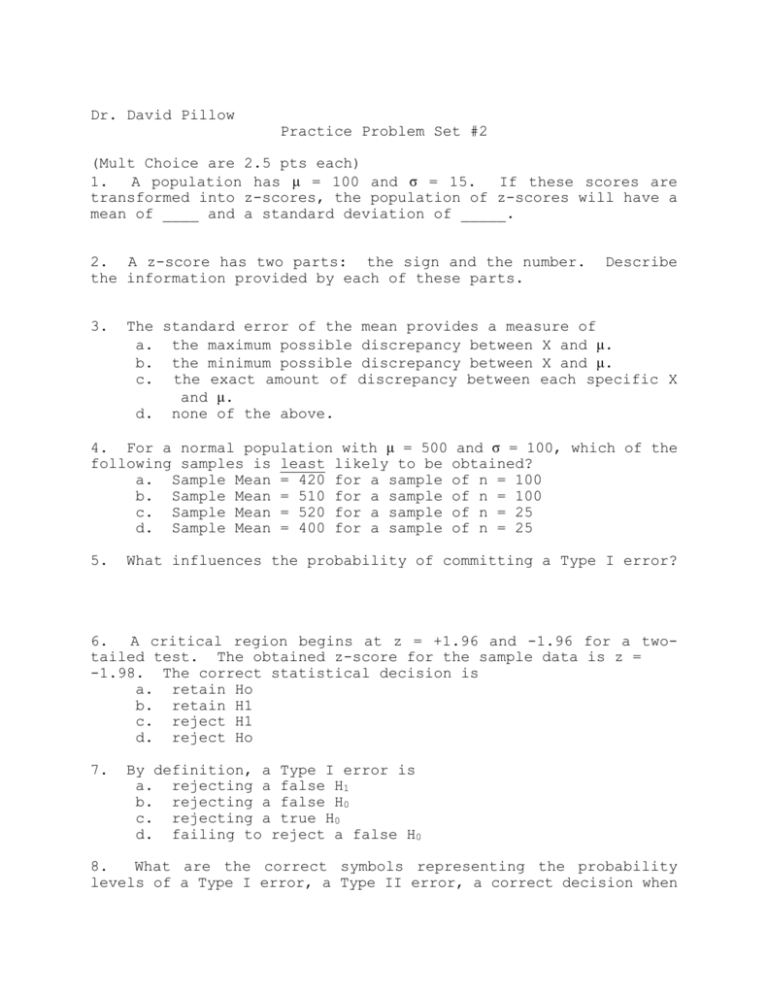
Dr. David Pillow Practice Problem Set #2 (Mult Choice are 2.5 pts each) 1. A population has μ = 100 and σ = 15. If these scores are transformed into z-scores, the population of z-scores will have a mean of ____ and a standard deviation of _____. 2. A z-score has two parts: the sign and the number. the information provided by each of these parts. 3. The standard error of the a. the maximum possible b. the minimum possible c. the exact amount of and μ. d. none of the above. Describe mean provides a measure of discrepancy between X and μ. discrepancy between X and μ. discrepancy between each specific X 4. For a normal population with μ = 500 and σ = 100, which of the following samples is least likely to be obtained? a. Sample Mean = 420 for a sample of n = 100 b. Sample Mean = 510 for a sample of n = 100 c. Sample Mean = 520 for a sample of n = 25 d. Sample Mean = 400 for a sample of n = 25 5. What influences the probability of committing a Type I error? 6. A critical region begins at z = +1.96 and -1.96 for a twotailed test. The obtained z-score for the sample data is z = -1.98. The correct statistical decision is a. retain Ho b. retain H1 c. reject H1 d. reject Ho 7. By definition, a Type I error is a. rejecting a false H1 b. rejecting a false H0 c. rejecting a true H0 d. failing to reject a false H0 8. What are the correct symbols representing the probability levels of a Type I error, a Type II error, a correct decision when the null is true, and power? 9. A positively skewed population has μ = 50 and σ = 20. A random sample of n = 4 scores obtained from this population has a mean of 55. What is the z-score corresponding to this sample mean? a. .50 b. .25 c. 2.0 d. cannot be determined because the population is not normal. 10. If variance a. b. c. d. sample size (n) is held constant, as the population increases the standard error will increase decrease stay constant cannot answer with the information given 11. As sample size increases, the expected value of the mean a. also increases b. decreases c. stays constant d. can only be correctly determined if the researcher counts his or her M&M's before eating them. 12. For a population with μ = 100 and σ = 20, the z value corresponding to X = 110 would be a. +2.0 b. +.50 c. 100/20 d. -.50 13. For a population with μ = 80 and σ = 16, find the X value that corresponds to a z score of -1.50. 14. By selecting a smaller alpha level, a researcher is a. attempting to make it easier to reject Ho. b. better able to detect a treatment effect c. reducing the risk of a Type I error d. all of the above 15. Describe the things that influence statistical power. 16. What is the difference between the law of large numbers and the central limit theorem? 17. Why is the mean considered an unbiased statistic? Give an example of a biased statistic and describe why it is biased. 18. Describe the binomial distribution and understand how and under what conditions the binomial distribution provides the foundation for the normal distribution. 19. A distribution is normal and has μ = 70 and σ = 20. the 80th percentile? 20. Suppose you role a two dice. will get 2 sixes? a. .50 b. .33 c. 2/36 d. 1/36 What is What is the probability that you 20a. Understand when the multiplicative and additive rules of probability apply. 21. Assume a normal distribution with μ = 200 and σ = 30. Use the Z-table in the back to answer the following questions. (a) What percentage of scores are between 150 and 200? (5pts) (b) What percentage of scores are between 205 and 285? (5pts) 22. Suppose you have a normally distributed set of raw scores with μ = 60 and σ = 10. You are screening subjects for an experiment and you have decided to take only people with raw scores between 43 and 66. What percentage of people are you accepting into your study? (5pts) 23. (5pts) Assuming that students were responding no better or greater than at chance on a test, what would be the mean number of correct answers expected by chance if there were 50 questions with 5 response options each? (Use the formulas for the normal approximation to the binomial distribution.) What would the standard deviation be? What would be the probability of getting a score of 15 or greater? (HINT: To get a score of "15 or better" means that you will need to include the 15 using the real limits--recall in class how we obtained the probability for a single score.) 24. Understand the expected value of the mean, the standard error of the mean, and understand how to compute the standard error of the mean if you are given σ and n. Z-TEST 25. A researcher is interested in evaluating the effectiveness of a new training strategy to enhance social sensitivity. Using a standardized measure of social sensitivity, the mean score is μ = 50 and the standard deviation is σ = 10. The researcher draws a random sample of size n = 25 from a large group of individuals who have recently received the new training. In this sample, the group mean on the standardized test is X(with bar over X) = 53. Does the new treatment significantly increase social sensitivity? Conduct a 2-tailed Z-test to test the hypothesis that the training is effective. Step 1: Specify the null hypothesis and the alternative hypothesis using the correct population parameters. (6pts) Step 2: Specify alpha at .05 and use the corresponding critical value where z = 1.96 to specify the region of rejection for a two-tailed test. Make a diagram of the regions of acceptance and rejection associated with the null hypothesis, labeling the horizontal axis using Z-score values. (6pts) Step 3: Calculate the Z-statistic; use the following information that the sample mean of X(with bar) = 53, where μ = 50, σ = 10, and n = 25. (6pts) Step 4: Make your decision. Given your answer in step 3, would you accept or reject the null hypothesis? Briefly state your conclusion (in your own words) regarding the effectiveness of the new training? (6pts)--Use back if needed. FORMULAE z = X - μ -----σ X = σz + μ Standard Error of the Mean: Z-test = _ X - μ -----σX = σ σX = ----N _ X - μ -----σ / N Probability: P(E1 or E2)=P(E1)+P(E2) P(E1 and E2)=P(E1)*P(E2) For Normal Approximation to the Binomial: μ = pn σ = npq
